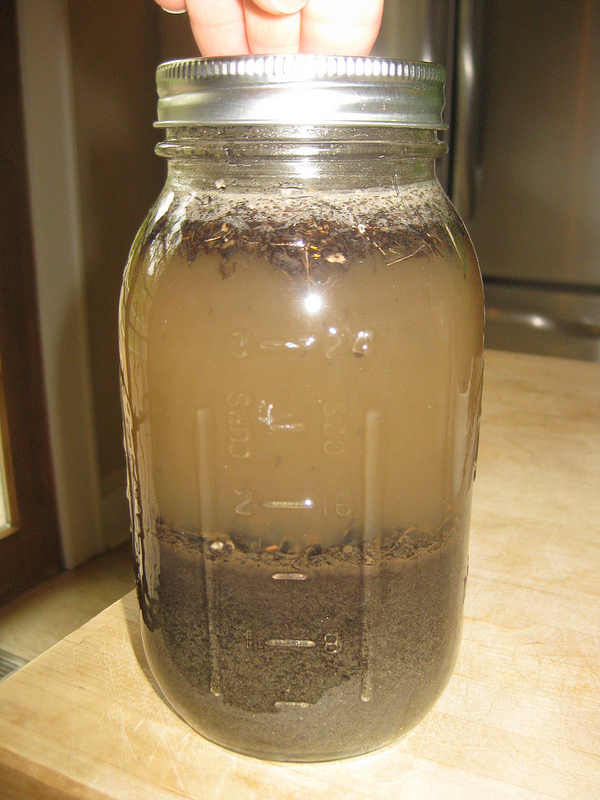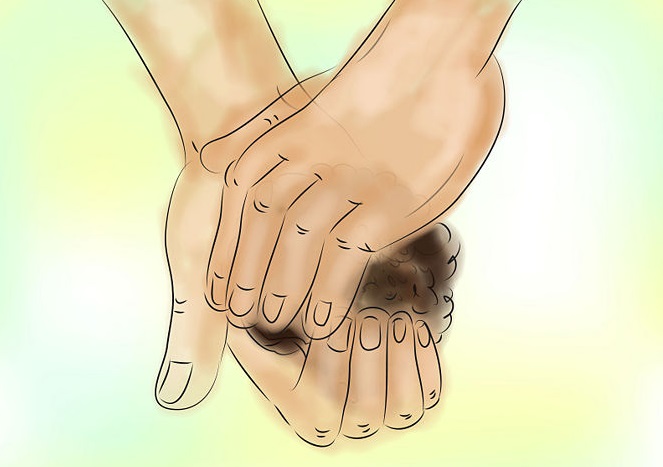What’s in Your Soil?
 Soil is a mixture of dirt (tiny bits of rock), organic matter (animal poops, dead insects, bacteria, leaves, etc.), and bits of rock (or bigger bits of rock). But soils in different places are different.
Soil is a mixture of dirt (tiny bits of rock), organic matter (animal poops, dead insects, bacteria, leaves, etc.), and bits of rock (or bigger bits of rock). But soils in different places are different.
Some soils have lots of sand (bits between 0.05-2mm), some have lots of silt (pieces between 0.002mm-0.05mm), and some have a lot of clay (teeny pieces smaller than 0.002mm). Even fine sand grains are just about too hard to see with the naked eye, but silt and clay are made from pieces so small that you need a microscope to see the individual grains. Plants like silt and some sand, but they have trouble pulling the water out of clay. Clay is sticky, while silt and sand are not. And sand is, well, sandy!
The Experiment
Let’s see what your soil is made of. There are a few common tests to sort out what your soil is made out of, so let’s give them a try!
What to Use
- screens of different sizes (try chicken wire, window screen, and any other ‘mesh’ you can get your hands on)
- a set of bowls, one for each screen +1 extra
- a clear bottle
- salt
- water
- a marker
What do you think will happen?
What do you think you will find in the soil at your home or school? Do plants grow well in some soils and not others? Try testing these soils – maybe you can find out why. Write down your predictions for the types of soil particles you think you will find in the different soils.
What to Do
TEST 1 – “Feel” Tests
How a soil feels and how it can be molded and shaped gives clues to the types of particles in it. Clay in soil makes it very stick and mouldable, while sand and silt make it crumbly.
a) Take a handful of soil and carefully add drops of water to it until it is like a hard ball of mud. If you add too much water, it will just wash the soil away. Try squeezing the ball with your hands and listen. Can you hear a lot of high scratching and squealing sounds? This means it probably has a lot of stones or sand particles in it that are scraping against each other.
b) Try dropping your ball from shoulder height onto a hard surface, like concrete sidewalk. Does the ball crack into pieces (meaning it probably has a lot of sand) or does it squish flat like a pancake (meaning it probably has a lot of clay in it)?
c) Now roll the ball between your two hands so it becomes long and thin, like a pencil. Hold one end and wiggle your dirt pencil back and forth. Does it break after 1 or two wiggles (meaning it doesn’t have a lot of clay in it) or can you wiggle it for ages before it breaks (meaning it has a lot of clay in it)?
TEST 2 – Screen Test
No, unfortunately this test won’t get you into the movies, unless they’re looking for a very convincing soil scientist!
d) Screen testing of soils is really simple and means just passing your soil through several screens of decreasing sizes. Measure the size of the holes in your screens and then pour a sample of dry soil through the biggest screen, catching whatever passes through in a bowl. Make sure that you manually (with your hands) break up the dry soil first as much as you can so that the particles are sticking together. Whatever passes the first screen will be used again in the next screen. Whatever doesn’t pass through the screen must be bigger than the holes in the screen, so you can put that material aside in a bowl labelled “Bigger than (size of screen holes)”.
e) Pour whatever passed through the first screen now through the next screen, and continue in this way, screening out and keeping the material that doesn’t pass a screen in a separate bowl. When you’re finished, you’ll have a set of bowls containing soil particles of different sizes (labelled as bigger than the screen size), and one extra bowl to collect whatever DOES pass through your finest/smallest screen. You can lay these bowls out in order to see compare how much of each particle size makes up your soil.
TEST 3 – Bottle Test
Stones and sand grains are too heavy to float, though they can be moved around by water. Silt, clay, and organic matter can float, so adding soil to water can tell us a lot about what it’s made of.
 f) Take a sample of soil and break/crush it up well. Add this to your clear bottle, then add water (about 2 times the amount of soil). Next, add 1 tablespoon of salt. Shake the bottle hard for about 3-4 minutes to make sure the soil is completely broken up and all wet. In case you didn’t think of it, PUT THE LID ON THE BOTTLE FIRST!!
f) Take a sample of soil and break/crush it up well. Add this to your clear bottle, then add water (about 2 times the amount of soil). Next, add 1 tablespoon of salt. Shake the bottle hard for about 3-4 minutes to make sure the soil is completely broken up and all wet. In case you didn’t think of it, PUT THE LID ON THE BOTTLE FIRST!!
g) When all the soil is broken up and your arms are aching, put the bottle down in a safe place and don’t touch it for several hours. Overnight is best. You’ll see right away that stones and sand will drop to the bottom of the bottle forming layers according to their sizes (big at the bottom, small at the top). You may also see stuff floating on the top, which will be light-weight organic material. The rest of the bottle should be filled with cloudy, muddy water. This is all the silt and clay floating in the water.
Why did you add salt? Well, silt is bigger than clay and it takes a few minutes to a few hours to sink to the bottom of the bottle, but clay particles are so tiny that they can float in the water for hours up to days. However, if they float around and bump into dissolved salt molecules, they will stick to them. With enough clay particles sticking together they will be like a big heavy particle and so they will sink. So the salt helps to speed up your test.
NOTE: After several hours or even overnight, you will see a layer of sticky mud on top of your sand layer at the bottom of the bottle, d the water above this should be clean and clear. The “mud” is silt and clay, however they’re both too small to see so this test can’t tell you exactly how much each of silt and clay you have!
What Did You Find?
Did you see what you predicted? Or were you surprised by what you found in your soil sample? Think about what you found and how it relates to the qualities of your soil. For example, sandy soils dry out quickly since water can drain through them, while silty soils can hold water for longer, making them the preferred soils for many plants.
Be sure, to check out how to make a canyon in a box!












